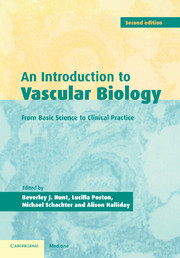Book contents
- Frontmatter
- Contents
- List of contributors
- Preface
- Part I Basic science
- 1 Vascular tone
- 2 Vascular compliance
- 3 Flow-mediated responses in the circulation
- 4 Neurohumoral regulation of vascular tone
- 5 Angiogenesis: basic concepts and the application of gene therapy
- 6 The regulation of vascular smooth muscle cell apoptosis
- 7 Wound healing: laboratory investigation and modulating agents
- Part II Pathophysiology: mechanisms and imaging
- Part III Clinical practice
- Index
7 - Wound healing: laboratory investigation and modulating agents
Published online by Cambridge University Press: 07 September 2009
- Frontmatter
- Contents
- List of contributors
- Preface
- Part I Basic science
- 1 Vascular tone
- 2 Vascular compliance
- 3 Flow-mediated responses in the circulation
- 4 Neurohumoral regulation of vascular tone
- 5 Angiogenesis: basic concepts and the application of gene therapy
- 6 The regulation of vascular smooth muscle cell apoptosis
- 7 Wound healing: laboratory investigation and modulating agents
- Part II Pathophysiology: mechanisms and imaging
- Part III Clinical practice
- Index
Summary
In recent years our understanding of the cellular and molecular mechanisms underlying the wound-healing process has increased considerably. As we enter the postgenomic era the potential to investigate the role and regulation of this vital response to injury at the gene level will elucidate the process further. Tissue repair is a series of interactive events between different cell types, the extracellular matrix (ECM) and a number of chemical mediators and has been the subject of many excellent reviews. As the field of wound-healing research has become too large to cover in depth in a single chapter, in the following chapter we will try to highlight crucial components of the wound-healing process, methods of investigating these components and, finally, ways in which the healing process can be modulated.
Wound healing: an overview
The repair of lost or damaged adult tissue is achieved by the production of scar tissue. The healing response generally consists of a series of ordered events, some of which occur concurrently, involving several cell types, regulators of cell function and ultimately the production and remodelling of new tissue (Figure 7.1). Variations in the processes involved in this response can result in inadequate or excessive healing, both of which may result in the impairment or loss of tissue or organ function.
- Type
- Chapter
- Information
- An Introduction to Vascular BiologyFrom Basic Science to Clinical Practice, pp. 129 - 166Publisher: Cambridge University PressPrint publication year: 2002
- 1
- Cited by

